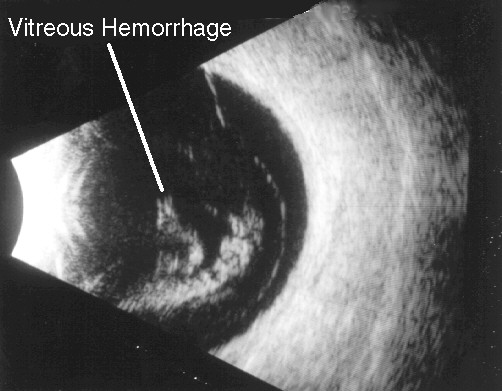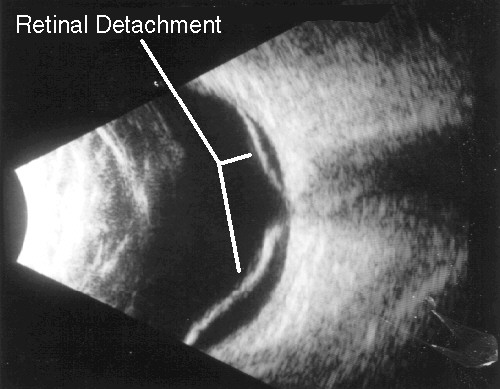Ocular and Orbital Echography
Ocular Echography
Light in the visible part of the spectrum has been used for millennia to examine the eye and diagnose ocular disorders. Since 1956, scientists have used high frequency sound waves, or ultrasound, to examine the eye and diagnose disorders that might not be visible using light. The interpretation of the reflections (or echos) of these ultrasound waves from ocular tissues is called ocular echography.
By definition, ultrasound waves have frequencies greater than 20 kHz (20,000 oscillations/sec), which is above the frequency which is audible to the human ear. The typical frequencies used in diagnostic ophthalmic ultrasound are in the range of 8 to 10 million oscillations/sec. The sound waves are produced by a small probe which is placed directly on the eye following the application of a topical anesthesia. The same probe is used to collect returning echos, and these echos are then processed to create an image of the globe. This painless, non-invasive technique can be easily performed in the clinic, at the patient's bedside, or in the operating room. In addition, ultrasound can readily be performed on children, often without sedation.
A major use of ocular echography is to examine the back of the eye in patients who have cloudy ocular media, such as cataract, corneal clouding, or blood in the vitreous fluid. B-scan echography uses a rapidly oscillating transducer to produce a 2 dimensional "slice" through the globe, similar to the image produced by a CT scan. However, the B-scan is far superior to CT images in detecting and distinguishing between the different structures in the eye. The echographic images are viewed on an oscilloscope, and movements of intraocular structures can be viewed in real time. Unlike CT, which uses potentially harmful ionizing radiation, echography utilizes high frequency sound waves at an intensity which appears to be very safe to tissues. One of the most frequent indications for ocular echography is to examine the retina in diabetic patients who have developed vitreous hemorrhage, to determine whether they have developed a potentially blinding condition called a retinal detachment.


Ocular echography is very useful in differentiating between various intraocular tumors. A vital component of this examination involves the use of standardized A-scan echography, as developed by our own Dr. Karl Ossoinig. Dr. Ossoinig's techniques have vastly improved our ability to detect and differentiate intraocular disorders and has allowed echographers to be able to compare and rely on the results of fellow investigators. A-scan echography is also frequently used by ophthalmologists to precisely measure the length on an eye prior to cataract surgery, to determine the strength of the lens implant to be placed in the eye at the time of cataract surgery.

Orbital Echography
Echography is also very useful in examining the soft tissue structures surrounding the eye. Infections, tumors, congenital abnormalities, inflammatory disease, traumatic disorders, and many other problems can be reliably diagnosed and followed using echography. In addition to standardized A-scan and B-scan instruments, a doppler instrument is also useful in examining the orbit, to listen for blood flow. The use of these instruments in combination with meticulous examination techniques as devised by Dr. Ossoinig has evolved into what is known today as Standardized Echography.
The Ophthalmic Echography Service evaluates about 75 patients a month, and is a resource used extensively by the other ophthalmic services at the University of Iowa as well as by ophthalmologists from Iowa and the surrounding states.
Locations and Offices



Patient Stories


